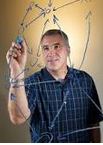Glitches in human awareness, perception and cognition are memorably illustrated in Apollo Robbins’ interactive Las Vegas, USA show, “The Gentleman Thief.”
He tells “targets” in the audience that he is about to steal from them, then uses visual illusions, proximity manipulation, diversion techniques, and attention control, to complete his imperceptible heists.
Robbins returns belongings to owners, including former US President Jimmy Carter’s Secret Service agents.
Robbins uses sleight-of-hand to help people improve perceptual capabilities.
These skills can reduce traffic accidents, industrial mishaps, and security violations.
He overcame his own motor-skill deficits by monitoring the focus of a target’s attention: “If a person is focused elsewhere, a thief can put his whole hand in [a pocket] and steal.”

Kim Silverman
Like Kim Silverman, Research Scientist at Apple, Robbins creates “false assumptions…that look like reality…”
The U.S. Department of Defense deploys Robbins’ skills at its Special Operations Command research and training facility at Yale University, where he is an adjunct professor, despite leaving school before university.
Defense application of these perceptual manipulation skills were identified by Barton Whaley of the U.S. Naval Postgraduate School and Susan Stratton Aykroyd in their Textbook of Political-Military Counterdeception.
Their historical survey of deception and counter-deception practices noted that amateur magicians’ practices were more advanced than those used by U.S. political or military intelligence analysts in the 1970s.
SUNY Downstate’s Stephen Macknik and Susana Martinez-Conde collaborated with Robbins on Sleights of Mind: What the Neuroscience of Magic Reveals about Our Everyday Deception.
Their empirical results supported Robbins’s observation that the eye will follow an object moving in an arc without looking back to its point of origin.
Curved motions may be more novel than linear edges, so they attract greater attention and contribute to illusions.
Perceptual errors in illusions can suggest diagnostic and treatment methods for brain trauma, autism, ADHD, and Alzheimer’s disease.
Observing illusion performances may help patients focus on the most important aspects of their environment, while suppressing distractions that cause confusion disorientation, and “inattentional blindness” (focusing so intently on a single task that one fails to notice things in plain sight).

Richard Wiseman
Psychologist and illusionist Richard Wiseman of the University of Hertfordshire demonstrated inattentional blindness when viewers fail to notice environmental changes while they focused on a card trick.
Similarly, Transport of London’s Public Service Announcement reminds viewers that it’s easy to miss things you’re not expecting in “Did you see the Moonwalking Bear?”
Wiseman suggested that people can recognise opportunities in life when they intentionally increase their attention, in his book Magic in Theory: An introduction to the theoretical and psychological elements of conjuring.

Daniel Simons
University of Illinois’s Daniel Simons and Daniel Levin of Vanderbilt University demonstrated that observers missed didn’t someone in a gorilla suit walked past people passing a basketball .
With Harvard’s Christopher Chabris, Simons reported that half of the observers said they missed this unusual detail when they were counting the number of ball passes by one team.
However, the same people easily recognized the gorilla when they were not asked to focus on a distraction task.

Edward Vogel
This finding shows that most people are unable to effectively “multitask” because they have limited ability to hold a visual scene in short-term memory (VSTM), suggested University of Chicago’s Edward K. Vogel and Maro Machizawa of Hiroshima University and separately by Vanderbilt’s René Marois and J. Jay Todd.
Gustav Kuhn of University of London collaborated with illusionist Alym Amlani and Ronald Rensink of University of British Columbia to classify cognitive, perceptual, and physical contributors in Towards a Science of Magic:
-

Ronald Rensink
Physical misdirection by a magician’s gaze or gesture,
- Psychological misdirection with a motion or prolonged suspense to distract from the trick’s mechanics,
- Optical illusions that distort the true size of an object,
- Cognitive illusions to prolong an image after the object has been removed,
- Physical force and mental force influence “freely chosen” cards or other objects in magic tricks.

Rene Marois-J Jay Todd
Perceptual and cognitive illusions can cause people not to see things that are present.
This effect can lead to overlooking interpersonal cues, life opportunities.
and more dangerously, inattention in traffic accidents, and victimization.
Mindful awareness helps people pay attention to the present experience and to opportunities while mitigating potential perceptual misinformation.
-*How to you maintain focus to reduce “inattentional blindness”?
Related Posts
©Kathryn Welds

















 Widespread
Widespread 
















































































